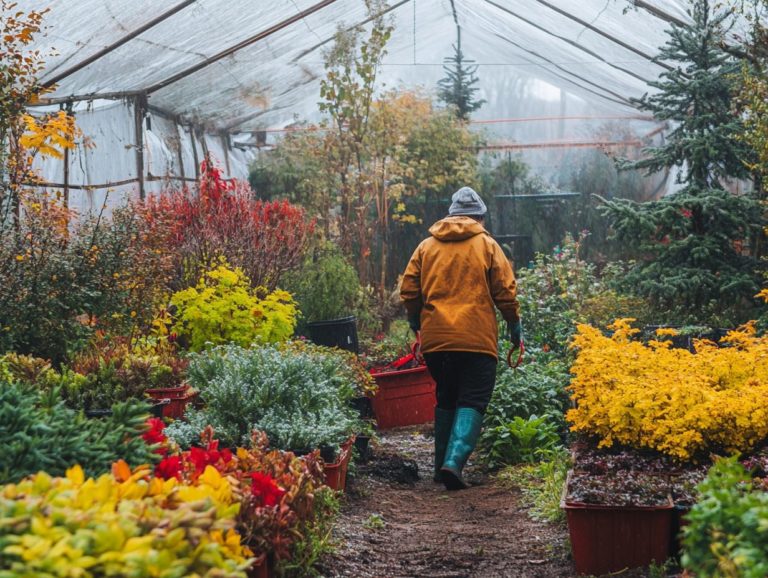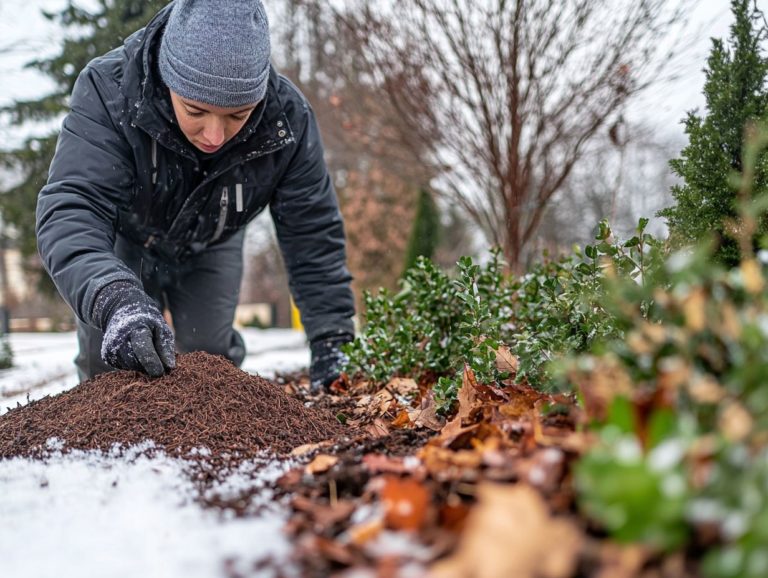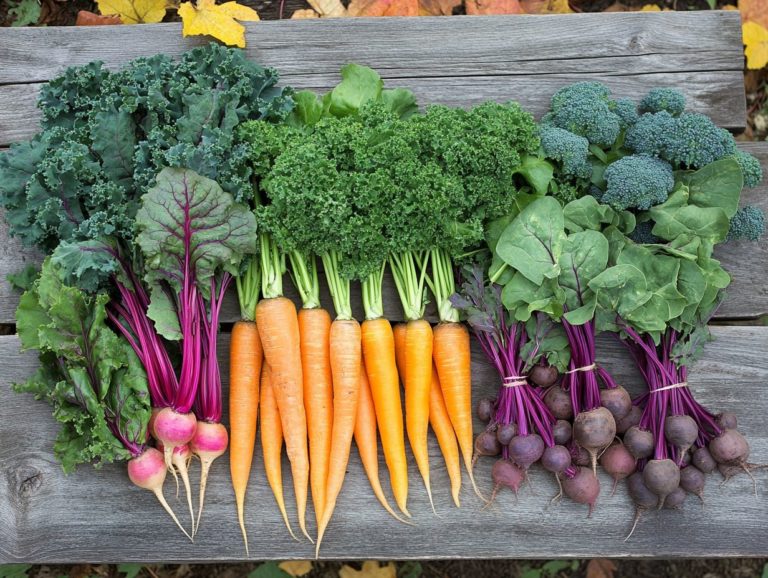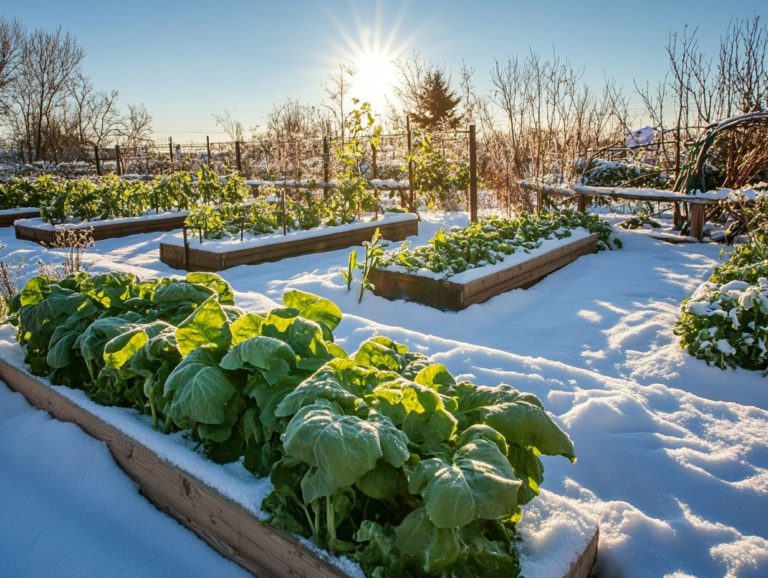Winter Gardening: Tips for Enthusiasts
Winter gardening may appear challenging, yet it presents a remarkable opportunity to nurture beauty and sustenance, even amid the coldest months.
This article delves into the advantages of gardening during winter, from savoring fresh produce to enjoying tranquil landscapes. You ll discover essential preparations, recommendations for resilient plants, and effective strategies to shield your garden from harsh weather.
You will also find invaluable tips for harvesting and preserving your winter bounty. Embrace the season, and watch as your garden transforms into a winter wonderland!
Contents
Key Takeaways:
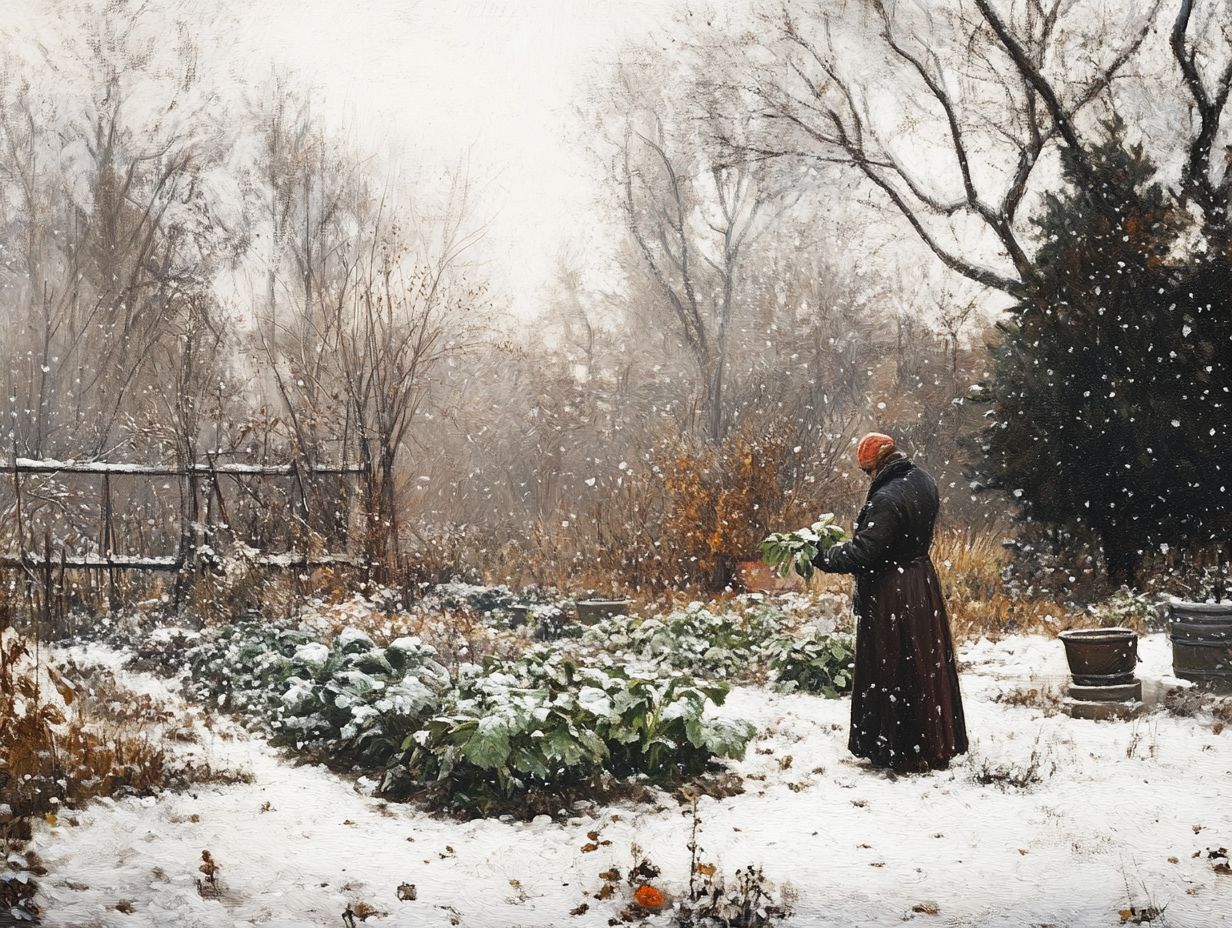
- Don’t let the cold weather stop you from gardening winter gardening has many benefits, including improving soil quality and providing fresh produce all year round.
- Prepare for winter gardening by stocking up on necessary tools and supplies and choosing the right cold-hardy plants for your climate.
- Protect your plants from frost and maximize sunlight and heat to ensure a successful winter garden. Be ready to troubleshoot common issues like pest control and learn how to properly harvest and preserve your winter produce.
What is Winter Gardening?
Winter gardening is all about cultivating plants during the colder months, especially in regions like Texas, where winter temperatures can fluctuate dramatically. By mastering this practice, you can extend your growing season and keep your garden productive, no matter how chilly it gets outside.
Whether you’re growing winter vegetables such as kale, broccoli, and carrots, or seasonal flowers to add color, understanding the nuances of winter gardening is key to maintaining a flourishing garden.
In Texas, winter gardening becomes particularly vital due to the unique climate, where temperatures can shift from mild to freezing in just a few days. This unpredictability can lead to challenges like frost damage to sensitive plants and the risk of desiccation from biting cold winds.
To tackle these hurdles, employ protective strategies such as row covers. Applying mulch not only retains moisture in the soil but also helps regulate temperature for your plants. Thoughtfully placing perennials can safeguard them from the elements, enhancing the resilience of your winter garden.
By understanding seasonal changes, you can adapt your gardening practices for better results and create vibrant, resilient landscapes that endure and thrive throughout the winter months.
Benefits of Winter Gardening
Winter gardening presents a wealth of advantages that elevate the aesthetic appeal of your garden while also serving as a sustainable food source. In Texas, where the climate provides exceptional gardening opportunities, even the colder months can be a fruitful time for cultivating your green oasis.
Why Garden in the Winter?
Gardening in the winter offers you a strategic opportunity to embrace the seasonal changes, allowing you to manage temperatures and maintain a thriving garden even as the chill sets in.
During this time, you can delve into effective gardening techniques. These will help you overcome winter’s challenges. Effective pest management is crucial in winter gardening to protect your plants from harmful pests and reduce your reliance on chemical solutions that could harm the environment.
Adopting organic gardening practices can improve soil health. These practices also enhance plant resilience during winter. Sticking to a consistent watering schedule ensures your plants receive the moisture they need while avoiding the pitfalls of waterlogged soil, which retains too much water and can harm plant roots.
Applying mulch provides an extra layer of protection, helping to maintain soil temperature and retain moisture, creating an optimal environment for your plants to flourish.
Preparing for Winter Gardening
Get ready for winter gardening by gathering essential tools that will help your plants thrive throughout the season. By doing this, you can maximize your gardening efforts and truly embrace the unique climate of Texas.
Tools and Supplies Needed
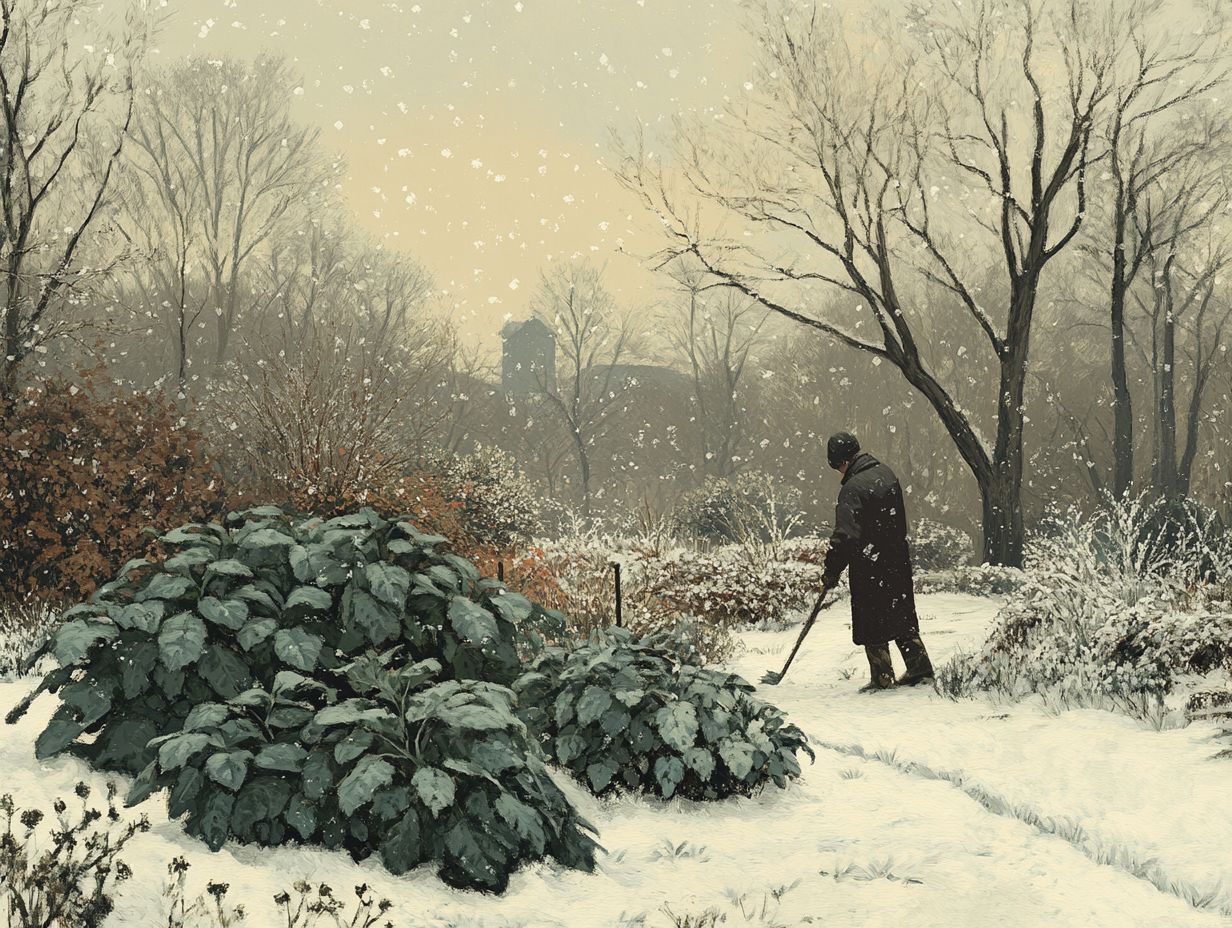
To navigate winter gardening successfully, having the right tools and supplies is essential. This encompasses both traditional tools and specialized equipment designed for cold-weather cultivation.
Key items include:
- Reliable irrigation system Maintaining healthy winter vegetables requires adequate moisture, even during the dry winter months.
- Compost Provides essential nutrients that enrich your garden’s soil.
- Protective covers Plant blankets or row covers shield delicate plants from frost, promoting healthier growth.
Pest management tools, including natural repellents, become essential as the seasons shift and introduce new challenges. These resources not only enhance overall plant resilience but also simplify your maintenance tasks, allowing you to focus more on nurturing your plants instead of battling the effects of winter.
Choosing the Right Plants
Selecting the right plants for winter gardening is essential for cultivating a thriving garden. Cold-hardy varieties, such as broccoli, kale, and carrots, flourish in cooler temperatures and can easily endure frost protection measures like cloches and row covers, which are vital to the success of your winter garden.
Embracing these resilient plants will not only enhance your garden s productivity during the winter months but also invite a rewarding experience as you nurture them through the chill.
Cold-Hardy Varieties and Other Considerations
Cold-hardy varieties, like legumes and winter vegetables, are your best friends in winter gardening, giving you the chance to harvest fresh produce even when temperatures drop.
Along with these stalwarts, consider incorporating plant species such as kale, spinach, and hardy onions. These resilient plants thrive in harsh conditions, ensuring your garden stays vibrant even in winter and providing consistent yields, enriching your winter landscape with vital nutrients during a time when fresh options are scarce.
To optimize growth, it s wise to manage temperatures by using protective coverings and establishing a well-planned watering schedule. This ensures your plants receive the moisture they need without falling victim to waterlogging.
Adding a layer of mulch can work wonders, too. It helps regulate soil temperature, retains moisture, and keeps pesky weeds at bay, all of which contribute to a healthier winter garden for you to enjoy.
Winter Gardening Techniques
By employing effective winter gardening techniques, such as using frost protection, utilizing greenhouses, and strategically placing your plants, you can significantly enhance your yield while safeguarding your plants from harsh weather conditions.
Protecting Plants from Frost and Snow
Protecting your plants from frost and snow is essential for winter gardening. Taking proactive steps ensures their survival in chilly winter temperatures.
By employing various techniques, you can maintain a healthy garden even when the harshness of winter sets in. One effective method is using row covers, which create a protective layer that traps heat and shields your plants from frost. You might also consider cloches transparent structures that form a mini-greenhouse effect around individual plants.
If you’re looking for a more permanent solution, utilizing greenhouses allows for better temperature regulation and protection against the elements. Each of these methods plays a vital role in fostering a resilient garden, ensuring your plants not only survive but thrive even in the cold.
Maximizing Sunlight and Heat
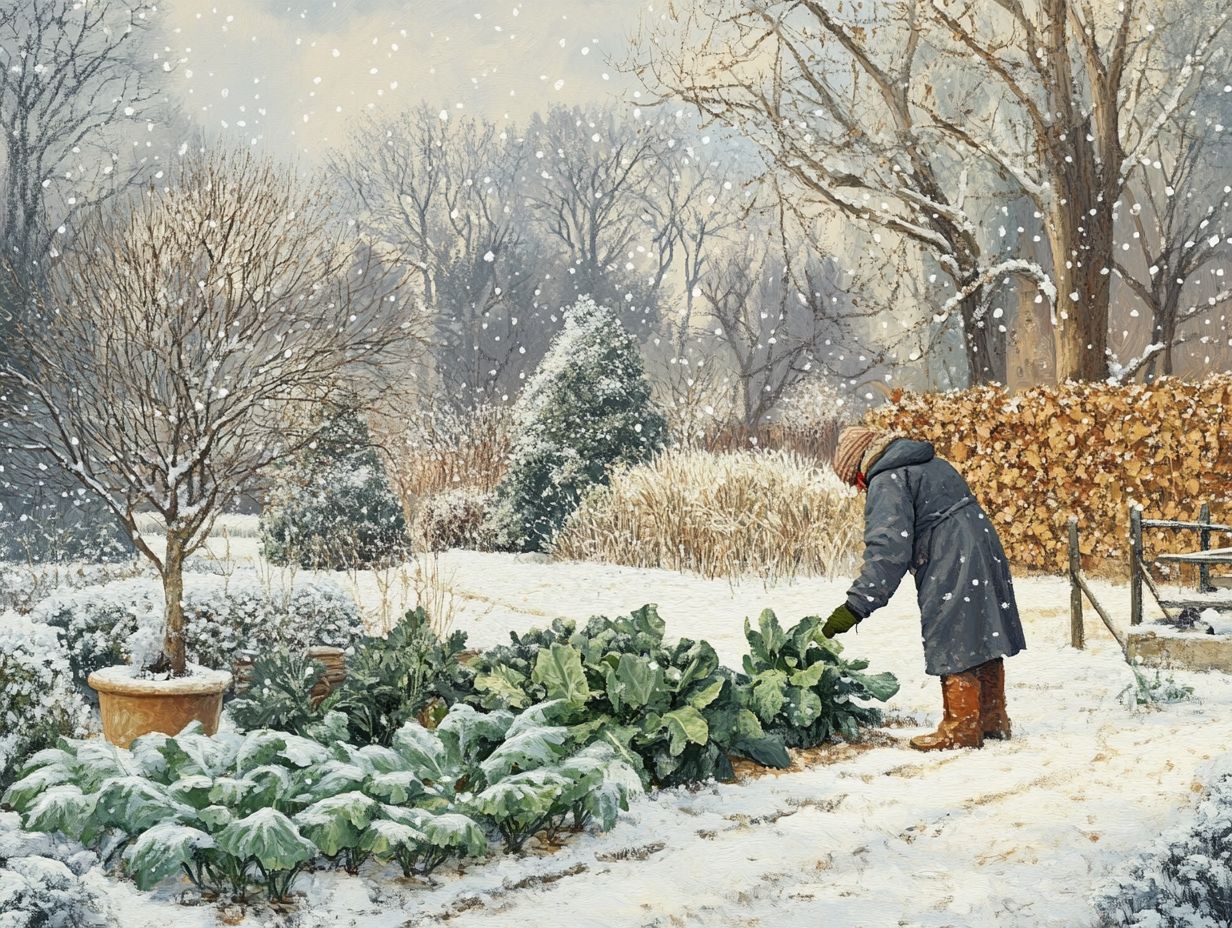
Maximizing sunlight and heat is essential for your winter gardening success. Your plants need warmth and adequate light to thrive despite the chill.
Pay careful attention to optimal plant placement, as it can significantly enhance your gardening experience. Consider the sun’s path when identifying the best spots for your chosen varieties. Positioning your plants near south-facing windows or walls can grant them extra exposure to sunlight.
Effectively utilizing greenhouses allows you to manage temperatures and create a controlled environment where light can be harnessed to sustain warmth. Incorporate reflective surfaces to amplify sunlight, transforming your greenhouse into an inviting haven for your plants.
Troubleshooting Common Issues
Facing challenges in winter gardening? Let’s troubleshoot together to keep your garden thriving. Addressing issues like pests and adverse weather conditions can significantly enhance both growth and yield.
Pest Control and Other Challenges
Effective pest control should be a top priority during winter gardening. Some pests thrive in colder temperatures, putting your precious plants at risk.
You must consistently care for your plants by watering and mulching, where understanding the lifecycle of those persistent pests is essential. Winter gardening presents unique challenges, such as limited sunlight and reduced airflow, which can exacerbate pest issues.
To tackle these challenges, consider using natural barriers like row covers to protect your delicate plants while still allowing necessary sunlight to nourish them. Maintaining a healthy garden environment through well-aerated soil and a robust compost heap will enhance your plants’ immunity, making them less enticing to unwelcome visitors.
By integrating these gardening techniques, you can significantly boost your success during the colder months.
Harvesting and Preserving Winter Produce
Harvesting and preserving winter produce is crucial for maximizing the advantages of winter gardening. This practice enables you to savor the flavors of homegrown food during the colder months and into the vibrant days of spring.
With these tips, you’re well on your way to a vibrant winter garden!
Tips for Storing and Using Your Winter Harvest
Properly storing and using your winter harvest is essential for ensuring the longevity and quality of your produce. This allows you to enjoy delicious meals even when your garden beds are taking a breather.
To keep vegetables like carrots and kale fresh and flavorful, you need to use the right storage methods. For instance, placing carrots in a container filled with sand or damp paper towels helps maintain moisture while allowing air circulation. This is key to preserving their delightful crispness.
Kale does best in a loosely sealed bag in the refrigerator; this keeps it cool and protects it from moisture that can lead to wilting.
Equipping yourself with reliable gardening tools also plays a significant role in harvesting your produce at the perfect moment, enhancing its freshness. Keep your meals vibrant and nutritious all winter long by knowing how to store your seasonal delights!
Frequently Asked Questions
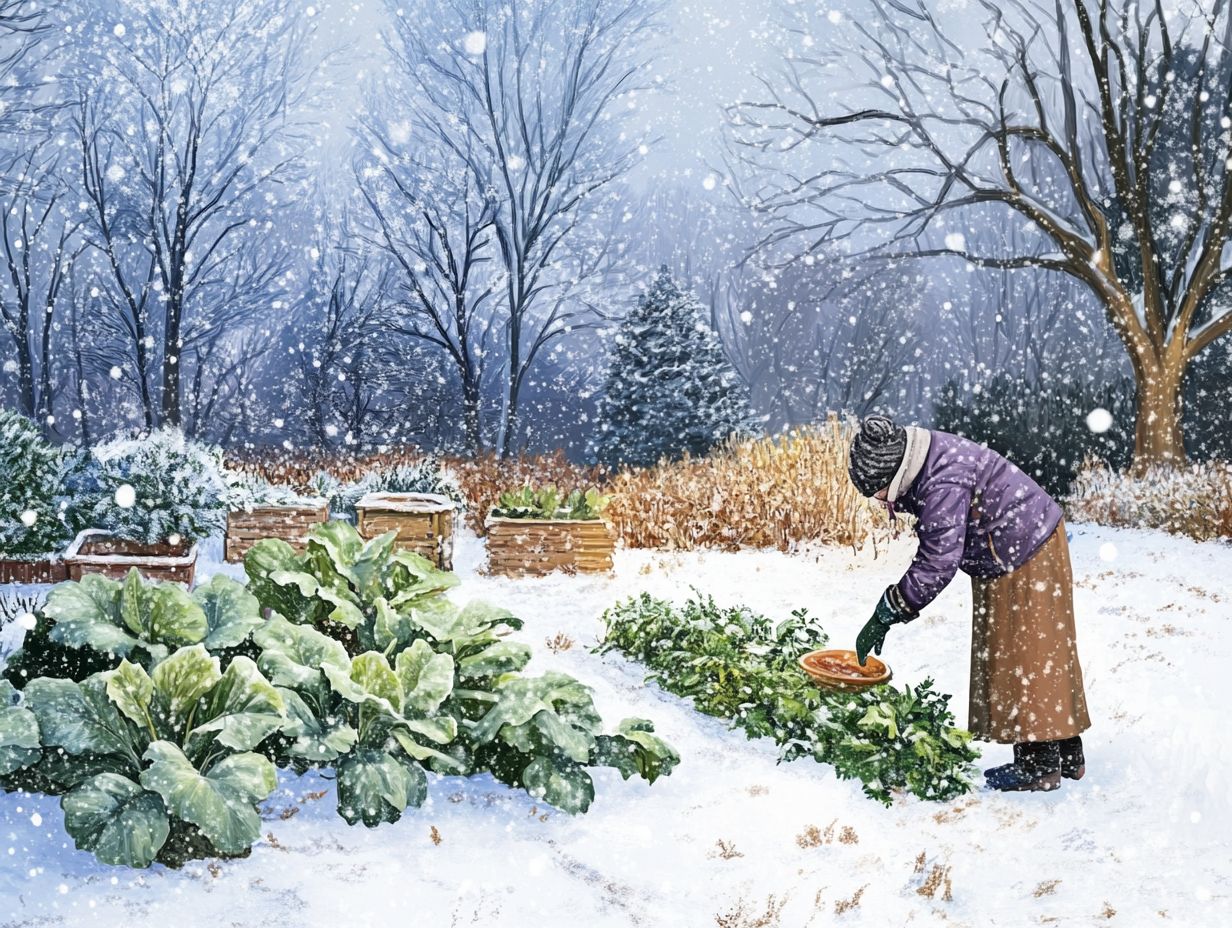
What is winter gardening?
Winter gardening is the practice of growing plants and vegetables during the colder months of the year. It’s a great way to stay engaged with your garden even in winter!
What are the benefits of winter gardening?
Winter gardening allows gardeners to continue their hobby and enjoy fresh produce despite the cold. It s a rewarding way to make the most of your gardening skills year-round.
What are some tips for successful winter gardening and outdoor maintenance?
Successful winter gardening includes choosing cold-hardy plants, using protective coverings like mulch or special covers that protect your plants from cold weather, and providing adequate water and light.
What are some plants that thrive in winter gardens?
Plants that thrive in winter gardens include winter vegetables such as kale, cabbage, and Brussels sprouts, along with winter flowers like pansies and camellias.
How can I protect my garden from harsh winter weather?
To protect your garden from harsh winter weather, use mulch to insulate the soil, cover plants with row covers or cloches, and choose cold-hardy plants that can withstand freezing temperatures.
Can I start a winter garden from seeds?
Yes, you can start a winter garden from seeds. However, it may be more challenging since seeds typically require warmer temperatures to germinate. You may need to start your seeds indoors and transfer them to your winter garden once they have sprouted.
Get started on your winter garden today and enjoy fresh produce all season!

